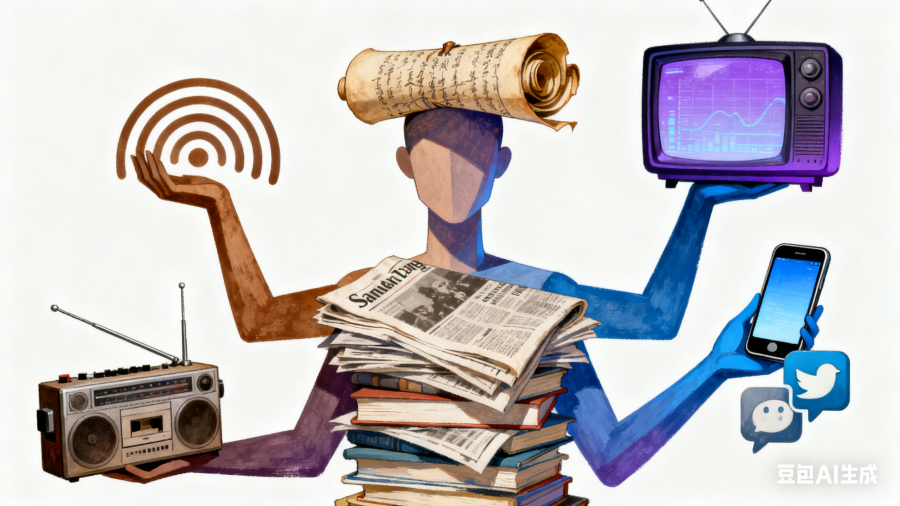Two step flow theory
When we think about how the Italian government communicates with people, it’s easy to imagine big press conferences, official speeches, or news headlines doing all the work. But in reality, that’s rarely how opinions are formed. Most of us don’t sit through long political statements or read government documents; we hear about them through someone else. That’s exactly what the Two-Step Flow Theory explains.
Back in the 1940s, researchers Paul Lazarsfeld and Elihu Katz discovered that the media don’t usually change our minds directly. Instead, messages first reach “opinion leaders,” people who pay close attention to the news, understand it, and share their take on it, and then the rest of us form opinions based on what those people say.
And if there’s one country where this idea fits perfectly, it’s Italy.
From Government to the Media Voices
In Italy, politics and media have always been close, sometimes too close. Think of Silvio Berlusconi, who literally owned major TV networks while serving as Prime Minister. Even now, journalists, talk show hosts, and influencers often act as middlemen between the government and the public.
When the government introduces a new law or policy, it’s not the Prime Minister’s full speech that most people hear, it’s a five-minute TV clip, a headline, or a tweet from a journalist explaining what it really means. These media figures add their own tone and interpretation, whether positive or critical, and that framing deeply affects how we understand the government’s message.
During the pandemic, this dynamic was on full display. Every government announcement was followed by endless TV debates, expert opinions, and social media reactions. The public didn’t just listen to what the government said, they listened to what the media said about what the government said.
From Media to the People
That’s the second step. Once those opinion leaders have shared their views, the rest of us pick up the information filtered, simplified, and sometimes emotionalised. Maybe we hear a friend quote something they saw on a morning show. Maybe we scroll past a meme mocking a new policy. Either way, our understanding of government communication is shaped by others, not directly by politicians.
In Italy, where media personalities have strong fan bases and clear political leanings, this process creates echo chambers. People tend to trust voices that align with their beliefs, so one policy can sound heroic on one network and disastrous on another. The government’s original message gets broken into multiple, sometimes contradictory, versions of the truth.
Social Media and New Influencers what’s happening today’s
Of course, social media has given this theory a modern twist. Now, TikTokers, YouTubers, and Instagram creators are the new opinion leaders. The Italian government knows this it’s why we see more attempts to communicate online, using short videos or influencer collaborations to connect with younger audiences.
But even those efforts go through filters: algorithms, comment sections, and the interpretations of digital communities. In the end, the two-step flow still rules. The message might start with the government, but it reaches us through people we already trust.
The takeaway? In Italy, media power isn’t just about who speaks first, it’s about who translates the message for everyone else. And that’s what really shapes public opinion.
Reference
katz, elihu (2024). The Two-Step Flow of Communication: An Up-To-Date Report on an Hypothesis on JSTOR. Jstor.org, [online] vol.21, No.1(1). https://doi.org/10.2307/2746790
Blackboard (2025). Blackboard. [online] Westminster.ac.uk. Available at: https://learning.westminster.ac.uk/ultra/courses/_102764_1/outline/file/_5981286_1 [Accessed 12 Nov. 2025].
Stromback, D. (2018). Cultures and social media: are social media bringing our cultures together? [online] Medium. Available at: https://medium.com/@strom582/cultures-and-social-media-are-social-media-bringing-our-cultures-together-378365e398de.


This article is really well written! It is very natural to combine the old theories of decades ago with the current situation in Italy, and it is not difficult to read at all. It is simply too clever to use the example of Italian political media relations to illustrate the “two-level communication” – Berlusconi’s example is particularly convincing, which makes people understand at once why opinion leaders are so important in Italy. The examples of media interpreting policies during the epidemic are also very down-to-earth. Who hasn’t seen several experts quarrelling on TV? I especially like the part where you put traditional media and social media together, which not only respects the classical theory, but also gives it the vitality of the new era. When it comes to TikTok and Internet celebrities, I immediately feel that this theory is not out of date at all. This article makes a theory that sounds quite academic clear, and makes people really feel how this theory works in reality. Great!
This is such a clear, engaging breakdown of how Two-Step Flow Theory plays out in Italian government communication—loving how you tied classic theory to real-world examples like Berlusconi, the pandemic, and modern social media influencers! Your explanation of “opinion leaders” as the bridge between politicians and the public is spot-on, and it’s fascinating to see how the dynamic has shifted (but stayed true to the theory) with TikTok and Instagram. For a quick boost, you could add a tiny nod to current examples like Italian political figures (like Giorgia Meloni) killing it on social media—showing how the government is now leaning into those new opinion leader spaces directly. Great job making a classic theory feel fresh and relevant to today’s media landscape!